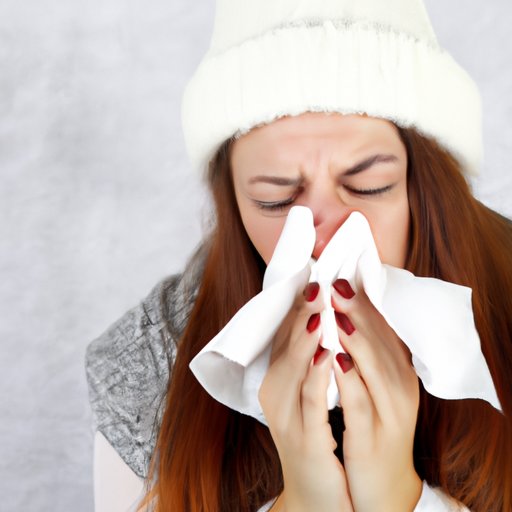
Introduction
When you think of allergies, you might picture blooming flowers and fresh-cut grass in the spring and summer months. However, allergies can affect people year-round, including during the winter months. In fact, winter allergies can be just as bothersome and disruptive to daily life as any other type of allergy. In this article, we will explore winter allergies and their symptoms, common allergens, climate change’s effect on allergies, prevention and management techniques, personal stories, and how to differentiate winter allergies from other illnesses.
Symptoms of Winter Allergies
Winter allergies are typically caused by indoor allergens such as dust mites, mold, and pet dander. However, outdoor allergens like pollen and grass can cause winter allergies in some areas, too. The most common symptoms of winter allergies include runny nose, nasal congestion, coughing, sneezing, itchy eyes and throat, and fatigue. These symptoms can be similar to those of the common cold and flu, making it difficult to distinguish between the two. However, allergies do not usually cause a fever, whereas the flu typically does.
Common Winter Allergens
Dust mites are the most common winter allergen and can be found in many areas of a home – from carpets to bedding to furniture. Mold thrives in damp environments like basements, bathrooms, and kitchens, making it a prime allergen source during winter months. Pet dander can also cause allergies in colder months when animals tend to spend more time indoors. In addition, outdoor allergens like pollen and ragweed can cause allergies in certain areas during winter.
Climate Change and Winter Allergies
Climate change is affecting allergies all year round, including winter months. The higher than usual temperatures during winter can prolong the pollinating season for plants and trees. As a result, there is a longer time for people to suffer from allergies. In other areas, decreased snowfall during the winter can lead to less water on the ground. This dryness creates environments that can cause dust mites and mold to thrive and grow faster.
Prevention and Management of Winter Allergies
Preventing winter allergies begins with identifying and avoiding allergens inside and outside your home. Wearing a scarf can help prevent an individual from inhaling cold air that irritates the nasal passages. Using a humidifier to keep the air in your home moist can also prove useful. Regularly cleaning your home can also help. Additionally, medication can help alleviate allergy symptoms. Using antihistamines and nasal decongestants as prescribed by a doctor could also be beneficial. For severe allergies, immunotherapy is an option.
Personal Stories and Testimonials
Many individuals suffer from allergies, and everyone has their way of managing them. Sharing personal stories and testimonials can help communities support one another. For instance, what works best for one person may not be the solution for another. But by sharing stories, individuals can learn how to manage their allergies and hopefully realize that no one is alone in the experience.
Winter Allergies Versus Other Illnesses
The symptoms of winter allergies and colds are very similar and the leading cause for confusion. However, they can be distinguished. Colds usually last a few days to a week, while allergies can last for several weeks or months. Additionally, body aches and fever are symptoms of a cold, not an allergy.
Differentiating Winter Allergies from Illnesses
Differentiating winter symptoms begins with determining the cause of the illness. For instance, a common cold typically lasts longer than a week and is accompanied by body aches and a fever. On the other hand, if an individual is experiencing allergy symptoms, they should be able to determine the allergy’s cause. If an individual treats their allergy symptoms without relief, they should visit a doctor to determine if they are suffering from an illness or other underlying medical condition.
Conclusion
Winter allergies should not be overlooked. Identifying and managing allergens, preparing for climate changes and taking proper medication are essential strategies. By following these tips, individuals can ensure proper prevention and management of winter allergies. Everyone should seek additional medical advice when necessary to treat the symptoms and to maintain their daily routine and quality of life.




